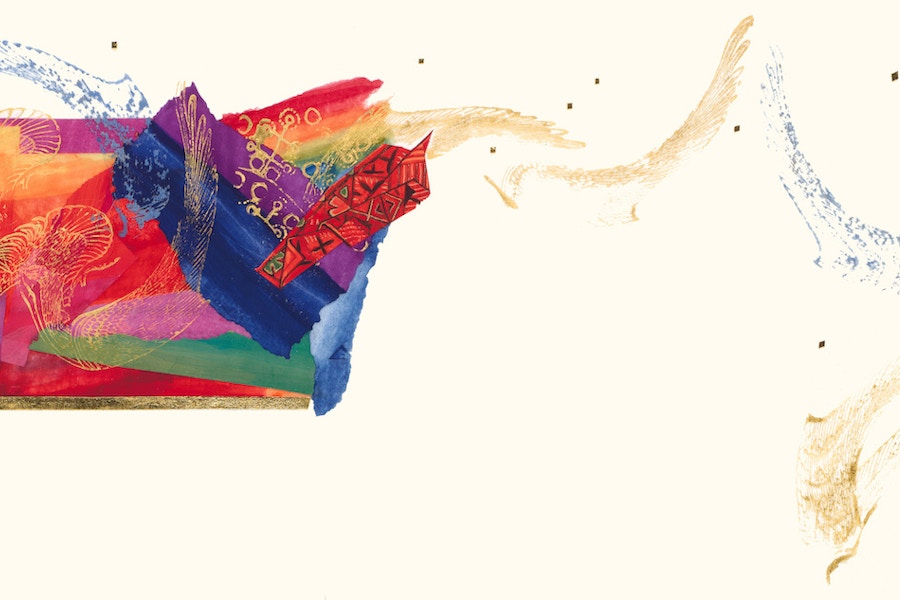Revelation 16
Revelation 16 now envisions the seven bowls of God’s wrath to be poured out upon the nations, punishing those who have worshiped the beast. Painful sores, bloody sea and rivers — because they have shed the blood of saints and prophets, they are now given blood to drink (vv. 1 – 5).
The sun scorched those who had cursed God, the throne of the Beast is cast into darkness, the Euphrates is dried up, and worldly kings assemble on Harmagedon (vv. 8 – 16). The seventh angel’s bowl is poured into the air, and huge hailstones fall upon the unrepentant (vv. 17 – 21).
Here we see the turning of tables; those who had succumbed to Empire will now face the wrath of God, and, like the plagues of Egypt (Exod 7 – 12), God will have the last word.
Donald Jackson’s painting, “Decorative Element” (The Saint John’s Bible, Vol. 7) depicts actions in the heavens and situations on earth.

Revelation 17
Revelation 17 features again a subject of female power and authority, as did ch. 12, but this time it is a negative image: the woman who rides on the Beast — the great whore of Babylon. She is drunk with the blood of the saints, and nations have conspired with her against the faithful (vv. 1 – 6).
The last verse connects her image with Rome, the city upon seven hills, and in my view, she represents the goddess Roma, whose statues in cities and towns throughout the Empire were used to call all citizens to appreciate the values of stable economies, infrastructures, and protection within the Pax Romana.
For believers in Jesus, though, the imperial cult posed a problem. Saying no to emperor-worship brought about punishment and penalties — physical, societal, and commercial. The reticence of the Jesus movement became a distinctive problem, which is why John describes the compliance of local governments as war against the Lamb (vv. 9 – 14).
In that sense, Revelation 17 challenges the use and misuse of female power and authority to further idolatry and imperial hegemony. See again the striking painting by Donald Jackson in depicting this critique: “Woman and the Dragon” (The Saint John’s Bible, Vol. 7).

Revelation 18
Revelation 18 pronounces the final fall of Babylon the Great. The kings of the earth, merchants, and artisans who have profited from her imperial clout will weep for her loss, but it will come in a single day — even a single hour (vv. 10, 17, 19).
And yet, there is rejoicing in heaven over these events by the saints, apostles, and prophets (v. 20). Like the impact of waves of a giant millstone thrown into the sea, the proud and mighty empire will be no more (vv. 21 – 24).
Again, these visions are violent, but they do not call for humans to resort to violence; such is the means of worldly empires.
Rather, they see God breaking into human history and setting things straight — meting justice to the oppressors and blessing to the oppressed — in God’s ways and timing.
Then as now, the faithful are invited to trust and obey; God is and will be making things right.
Revelation 19
Revelation 19 continues with visions of God’s agents defeating the worldly powers and liberating humanity from their oppressive rule.
At these victories, heavenly choirs ring out with praises to God and the fourfold sounding of “Hallelujah” — praise the Lord — as truth and justice win out over hegemony (vv. 1, 3, 4, 6).
On one hand, the victories of the rider on the white horse over the Beast and the false prophet are portrayed as violent and gruesome. On the other hand, his sword is what comes from his mouth — the incisive power of truth and revelation (vv. 15, 21).
Indeed, on that Last Day and every day, the true words of God (v. 9) and the One who is called “Faithful and True” (v. 11) are the true sources of righteousness, justice, and liberation, and he is indeed worshiped as “the Word of God” (v. 13; cf. John 1:1 – 5).
Revelation 20
Revelation 20 depicts a thousand-year period, where the powers of evil would be bound, and the martyred saints would come back to life to rule the earth, reigning with Christ for a millennium (vv. 1 – 6).
After that, Satan will be released and will deceive the nations before finally being thrown into the lake of fire (vv. 7 – 10).
Those whose names are written in the book of life, though, are redeemed (v. 12), and even death and Hades will finally be thrown into the lake of fire (v. 14).
While some try to make timetables out of periods and sequences, the main value of these visions is that they give hope to the faithful, even amidst the worst of trying times. Again, in the end, God wins.
Revelation 21
Revelation 21 puts forward a vision of the New Jerusalem — a heavenly city with the glory of God as its light, founded upon the twelve tribes of Israel and the twelve apostles of Jesus. In that city, suffering will cease, and God’s ways will be honored (vv. 3 – 4).
“See, the home of God is among mortals.
He will dwell with them;
they will be his peoples,
and God himself will be with them;
he will wipe every tear from their eyes.
Death will be no more;
mourning and crying and pain will be no more,
for the first things have passed away.”
The measurements of the city are listed, and in Western architecture, many a new metropolis has been planned with this sort of blueprint in mind, giving hope for a new and righteous reality that overcomes the chaos and travail of the world.
In his full-page size painting in Volume 7 of The Saint John’s Bible, Donald Jackson’s painting, “Vision of the New Jerusalem” portrays the Son of Man at the top, illuminations within the city walls, and the paradisal Tree of Life at the side. A wondrous vision of hope!

Revelation 22
Revelation 22 closes with messages from Christ and his messenger angel to John, declaring that he is coming soon. The river of life flows through the city, and in that garden, the leaves of the tree of life provide healing for the nations (vv. 1 – 3). Indeed, we could use that today!
Note that the Bible begins and ends with visions of a paradisal garden, inviting all humanity into restored relationship with God, with others, and within oneself; and that invitation is especially clear in v. 17:
“The Spirit and the bride say, ‘Come.’
And let everyone who hears say, ‘Come.’
And let everyone who is thirsty come.
Let anyone who wishes take the water of life as a gift.”
Warnings at the end call for hearers and readers to not water down the message, lest they receive the plagues described in the text, and the final response to the Lord is (vv. 18 – 21), “Amen. Come, Lord Jesus!”
In this beautiful painting by Donald Jackson on the last page of Volume 7 of The Saint John’s Bible (“The Great Amen”), that welcoming invitation is sounded with finality.

Reflections © Paul Anderson, 2024. Used by permission of the author.
Find more reflections like these by joining Paul Anderson’s Daily Bible Readings Groups on Facebook or LinkedIn.
Images by Donald Jackson © 2002. The Saint John’s Bible, Saint John’s University, Collegeville, Minnesota USA. Used by permission. All rights reserved. Learn more at stjohnsbible.org.
Text First Published December 2023 · Last Featured on Renovare.org January 2024


